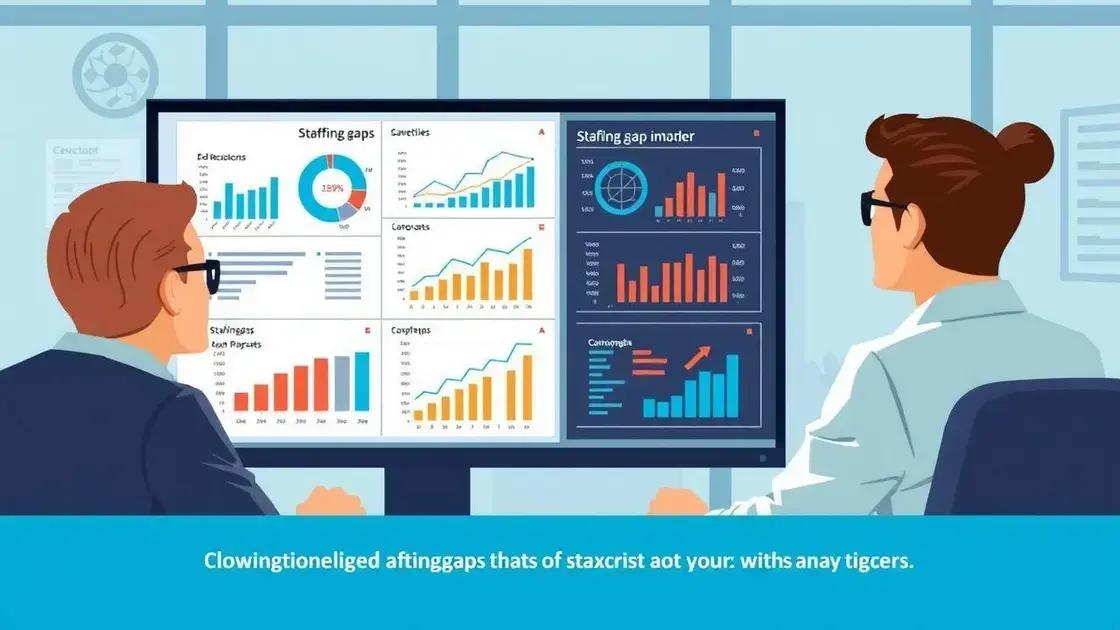Government agency staff insufficiencies report: what you need to know

The government agency staff insufficiencies report highlights critical staffing gaps that affect service delivery, emphasizing the need for innovative recruitment, employee retention strategies, and data analysis to improve workforce effectiveness.
Did you know that the government agency staff insufficiencies report highlights pressing challenges affecting public service? These gaps can have far-reaching effects on efficiency and community trust. Let’s dive into what this means for everyone.
Understanding government agency staffing issues
Understanding the staffing issues in government agencies is crucial for effective public service. Many agencies struggle with inadequate personnel, leading to decreased efficiency and public trust. Staffing problems can arise from various factors, including budget constraints, hiring policies, and employee retention challenges.
The impact of staffing shortages
When agencies face staffing shortages, the effects can ripple through the entire system. Services may be delayed, and citizens may experience longer wait times or reduced support. This situation often creates burnout among existing employees, as they are required to take on more responsibilities.
- Longer processing times for applications
- Decreased employee morale
- Increased workload on existing staff
Furthermore, understaffing can lead to a loss of valuable expertise. Experienced staff may leave for better opportunities, leaving gaps that are hard to fill. This cycle can perpetuate the staffing crisis within government agencies.
Common causes of staffing issues
Several factors contribute to the ongoing staff insufficiencies within government bodies. Understanding these causes is the first step toward finding solutions. Budget limitations significantly affect hiring capabilities, often leading to position freezes or unmet staffing needs.
- Budget constraints preventing new hires
- Lengthy hiring processes discouraging applicants
- Low salaries compared to the private sector
Additionally, the demanding nature of government work may deter potential candidates. Maladjusted work-life balances and lack of opportunities for advancement can make these positions less appealing. By addressing these root causes, agencies can begin to create a more sustainable workforce.
Consequences of staff insufficiencies
The consequences of staff insufficiencies in government agencies can be profound and far-reaching. When there are not enough staff members to handle the workload, the quality of services can decline significantly.
Effects on Service Delivery
Inadequate staffing levels often lead to delays in service delivery. For instance, applications or requests may take much longer to process, frustrating the public and eroding trust in government services. When citizens experience long wait times, they might begin to question the effectiveness of the agency.
- Longer response times for public inquiries
- Increased backlog of paperwork
- Reduced availability of support services
Additionally, staff members may become overworked, leading to burnout. This situation contributes to a cycle of high turnover, as employees leave for less stressful jobs. The effects are not just felt within the agency but can also impact the public’s perception and engagement.
Impact on Morale and Workplace Culture
Staff insufficiencies can create a challenging work environment. Remaining employees often feel overwhelmed by their workloads, which can lower morale. When teams are understaffed, collaboration becomes strained, and stress levels rise.
- Declining job satisfaction among remaining staff
- Higher rates of absenteeism
- Challenges in teamwork and collaboration
The combination of high stress and low morale can lead to a toxic work atmosphere. This situation makes it hard to recruit and retain new staff, further exacerbating the staffing crisis. Addressing these consequences is crucial for improving both employee well-being and public service delivery.
Analyzing data: Where are the gaps?

Analyzing data is essential for identifying staffing gaps within government agencies. By examining workforce metrics, agencies can uncover areas where staffing levels are inadequate. This process involves gathering and interpreting data related to employee performance, workload, and service delivery.
Identifying Key Metrics
To effectively analyze staffing gaps, agencies need to focus on specific metrics that reveal insights into their workforce. Some key metrics include:
- Employee turnover rates
- Workload distribution among staff
- Average time taken to process requests
These metrics help agencies determine where they experience shortages and how these insufficiencies impact service efficiency. For example, a high turnover rate may indicate that employees are overworked or dissatisfied with their roles.
Data-Driven Decision Making
Data analysis allows agencies to make informed decisions about staffing strategies. By understanding the gaps, leaders can prioritize recruitment efforts and allocate resources effectively. This approach promotes a more balanced workload across teams and improves employee morale.
Additionally, data can be used to forecast future staffing needs based on projected service demands. If an agency anticipates an increase in workload, proactive hiring can prevent further shortages.
Utilizing employee feedback and performance data is equally important. Surveys and assessments can provide insights into how staff feel about their workloads and work environment. Agencies that actively listen to their employees can better address the challenges they face.
Strategies for improving staffing levels
Implementing effective strategies for improving staffing levels is essential for government agencies facing shortages. These strategies help to attract and retain qualified professionals, ensuring that services are delivered efficiently.
Enhancing Recruitment Efforts
One of the first steps agencies can take is to enhance their recruitment efforts. This can be achieved through various methods, including:
- Utilizing social media and online job boards
- Hosting job fairs and informational sessions
- Partnering with local educational institutions
By broadening their outreach, agencies can connect with a larger pool of candidates. Quality job descriptions that highlight the benefits of government work can also attract interest.
Improving Employee Retention
In addition to recruitment, it’s vital to focus on retaining current employees. When staff feel valued and supported, they are less likely to leave their positions. Offering competitive salaries and benefits is crucial, but there are other factors to consider.
Establishing clear paths for career advancement can motivate employees to stay longer and grow within the organization. Providing ongoing training and development opportunities not only enriches skills but also demonstrates investment in employee futures.
Additionally, fostering a positive work environment is key. Regular feedback and recognition can boost morale and create a more engaged workforce.
Flexible Work Arrangements
Implementing flexible work arrangements can also help improve staffing levels. Many employees appreciate options that allow them to balance their personal and professional lives. Flexible schedules and remote work options can attract a wider range of applicants, including those who may have childcare or other responsibilities.
Creating a work culture that prioritizes work-life balance can enhance satisfaction and reduce burnout, keeping staff happy and healthy.
Case studies of successful staffing solutions
Examining case studies of successful staffing solutions provides valuable insights for government agencies facing challenges. These examples highlight practical strategies that have led to improved staffing levels and enhanced service delivery.
City A: Innovative Recruitment Approaches
City A faced significant staffing shortages in its public health department. To tackle this issue, they launched an innovative recruitment campaign that focused on local universities. By partnering with nursing and public health programs, they created internship opportunities that offered students hands-on experience in the field.
- Internships offered pathways to permanent employment
- Workshop sessions highlighted career benefits
- Collaborative events with school faculty attracted interest
This initiative not only filled job vacancies but also fostered a pipeline of skilled professionals eager to join the workforce after graduation.
County B: Employee Retention Programs
County B successfully improved retention rates by implementing employee support programs. They recognized that turnover was costly and negatively affected service delivery. To address this, they offered professional development opportunities and created mentorship programs.
These measures included:
- Regular training sessions to enhance skills
- Monthly feedback forums where staff could voice concerns
- Recognition awards for outstanding performance
As a result, the county saw a decrease in turnover rates and a boost in employee morale, contributing to a more stable workforce.
Agency C: Flexible Work Policies
Agency C implemented flexible work policies to attract a diverse range of candidates and retain existing employees. They recognized that offering remote work and adjustable schedules made jobs more appealing, especially for those balancing family responsibilities.
This approach allowed them to recruit individuals who might otherwise not have applied due to rigid work hours. The agency reported an increase in job applications and higher employee satisfaction scores after adopting these flexible policies.
FAQ – Frequently Asked Questions about Government Agency Staffing Insufficiencies
What are common causes of staffing insufficiencies in government agencies?
Common causes include budget constraints, lengthy hiring processes, and low salaries compared to the private sector.
How can government agencies effectively recruit staff?
Agencies can improve recruitment by utilizing social media, hosting job fairs, and partnering with local educational institutions.
What strategies are effective for retaining employees?
Effective retention strategies include providing training opportunities, mentoring programs, and recognizing employee achievements.
How does data analysis help in addressing staffing issues?
Data analysis helps identify staffing gaps, informs recruitment strategies, and allows for better resource allocation based on workforce metrics.





